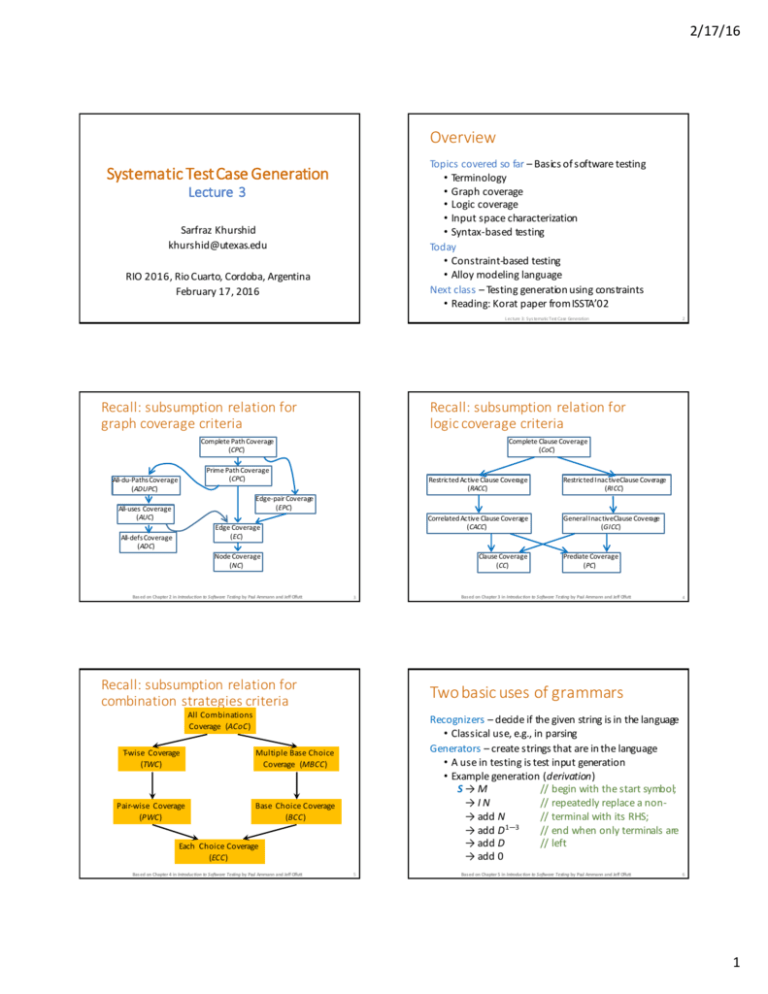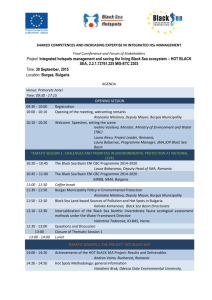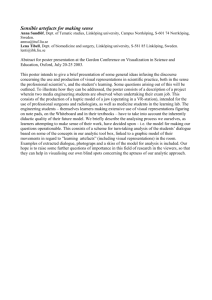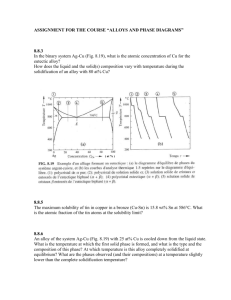Systematic Test Case Generation Overview Two basic uses of
advertisement

2/17/16
Overview
Topics covered so far – Basics of s oftware testing
• Terminology
• Graph coverage
• Logic coverage
• Input s pace characterization
• Syntax-­‐based testing
Today
• Constraint-­‐b ased testing
• Alloy modeling language
Next class – Testing generation u sing constraints
• Reading: K orat p aper from ISSTA’02
Systematic Test Case Generation
Lecture 3
Sarfraz Khurshid
khurshid@utexas.edu
RIO 2 016, Rio Cuarto, Cordoba, Argentina
February 1 7, 2 016
Lecture 3: S ys tematic Test Case Generation
Recall: subsumption relation f or graph coverage criteria
Recall: subsumption relation f or
logic coverage criteria
Complete Path Coverage
(CPC)
Complete Clause Coverage
(CoC)
Prime Path Coverage
(CPC)
All-­‐du-­‐Paths Coverage
(ADUPC)
2
Restricted Active Clause Coverage
(RACC)
Restricted I nactive Clause Coverage
(RICC)
Correlated Active Clause Coverage
(CACC)
General I nactive Clause Coverage
(GICC)
Edge-­‐pair Coverage
(EPC)
All-­‐uses Coverage
(AUC)
Edge Coverage
(EC)
All-­‐defs Coverage
(ADC)
Node Coverage
(NC)
Bas ed on Chapter 2 in Introduction to S oftware Testing by Paul Ammann and Jeff Offutt
Clause Coverage
(CC)
3
Recall: subsumption relation f or combination strategies criteria
Multiple Base Choice
Coverage (MBCC)
Pair-­‐wise Coverage
(PWC)
Base Choice Coverage
(BCC)
4
Recognizers – decide if the given string is in the language
• Classical u se, e.g., in p arsing
Generators – create s trings that are in the language
• A u se in testing is test input generation
• Example generation ( derivation)
S → M
// begin with the s tart symbol;
→ I N // repeatedly replace a n on-­‐
→ add N // terminal with its RHS;
→ add D 1—3 // end when only terminals are
→ add D // left
→ add 0
Each Choice Coverage
(ECC)
Bas ed on Chapter 4 in Introduction to S oftware Testing by Paul Ammann and Jeff Offutt
Bas ed on Chapter 3 in Introduction to S oftware Testing by Paul Ammann and Jeff Offutt
Two basic uses of g rammars
All Combinations
Coverage (ACoC)
T-­‐wise Coverage
(TWC)
Prediate Coverage
(PC)
5
Bas ed on Chapter 5 in Introduction to S oftware Testing by Paul Ammann and Jeff Offutt
6
1
2/17/16
BNF Coverage criteria
Mutation to g enerate invalid inputs
Terminal s ymbol coverage (TSC) – TR contains each terminal in the grammar
• #tests ≤ #terminals, e.g., 1 2 for our example
Production coverage ( PDC) – TR contains each production in the grammar
• #tests ≤ #productions, e.g., 1 7 for our example
• PDC s ubsumes TSC
Derivation coverage ( DC) – TR contains every string that can b e d erived from the grammar
• Typically, D C is impractical to u se
• 2 * ( 10 + 1 00 + 1 000) tests for our example
Using a grammar as a generator allows generating strings that are in the language, i.e., valid inputs
Sometimes invalid inputs are n eeded, e.g., to check exception h andling behavior or observe failures
Invalid inputs can b e created u sing mutation, i.e., (syntactic) modification – the focus of this chapter
Two s imple ways to create mutants (valid or invalid):
• Mutate s ymbols in a ground string
• E.g., “add 0” → “remove 0”
• Mutate grammar and d erive ground strings
• E.g., “I → add | remove” → “I → add | d elete”
Bas ed on Chapter 5 in Introduction to S oftware Testing by Paul Ammann and Jeff Offutt
7
Testing programs with mutation
Insight: in p ractice, if the software contains a fault, there will u sually b e a s et of mutants that can only be killed b y a test case that also d etects the fault
Approach: given a p rogram p
1. Create mutants of p
2. Remove redundant mutants ( if feasible)
3. Generate a test s uite for p
4. Run each test on p and its mutants to check mutant killing
5. Compute the mutation s core for the test suite
6. Check p ’s outputs for tests that kill s ome mutant(s)
Bas ed on Chapter 5 in Introduction to S oftware Testing by Paul Ammann and Jeff Offutt
Bas ed on Chapter 5 in Introduction to S oftware Testing by Paul Ammann and Jeff Offutt
8
6 example mutants
static int min(int a, int b) {
int minVal;
minVal = a;
if (b < a)
{
minVal = b;
}
return minVal;
}
Δ1, Δ3, Δ5: variable replacement
Δ2: relational op. replacement
Δ4: unconditional failure
Δ6: conditional failure
9
static int min(int a, int b) {
int minVal;
minVal = a;
Δ1 minVal = b;
if (b < a)
Δ2 i f (b > a)
Δ3 if (b < minVal)
{
minVal = b;
Δ4 fail();
Δ5 minVal = a;
Δ6 minVal = failOnZero(b);
}
return minVal;
}
Bas ed on Chapter 5 in Introduction to S oftware Testing by Paul Ammann and Jeff Offutt
10
Coverage criteria – mutation testing
Let M b e the s et of mutants of p rogram p
Strong mutation coverage (SMC) – for each m in M, TR
contains exactly one requirement, to strongly kill m
Constraint-­‐based testing f or OO programs
A brief introduction
Weak mutation coverage (WMC) – for each m in M, TR
contains exactly one requirement, to weakly kill m
# $%&'(&) *+,,-.
mutation s core = # $%&'(&)
• Consider n on-­‐equivalent mutants only (if possible)
Bas ed on Chapter 5 in Introduction to S oftware Testing by Paul Ammann and Jeff Offutt
11
2
2/17/16
Specs for OO programs
Example spec
Class invariant – properties of all valid objects of a class in all p ublicly visible states
• E.g., acyclic s tructure
Precondition – properties that a method expects of its inputs for correct b ehavior
• E.g., sorted array
Postcondition – behavioral correctness p roperties
• Can include exceptional b ehaviors
For p ublic methods, p reconditions and postconditions
include class invariants
Recall our s ingly linked-­‐list example:
public class SLList { // invariant: acyclicity
Node header;
int size;
static class Node {
int elem;
Node next;
}
int removeFirst() {
// precondition: header != null
// postcondition: returns the element in the first
//
node and removes that node if header != null;
//
else, throws NullPointerException
... }
}
Lecture 3: S ys tematic Test Case Generation
13
Lecture 2: S ys tematic Test Case Generation
14
Constraint-­‐based testing
Specs written as logical constraints
Input constraints – capture p roperties of d esired inputs
• E.g., method p reconditions and class invariants
• Enable test input generation
Oracle constraints – describe expected behavioral correctness p roperties
• E.g., method p ostconditions
• Enable test oracle automation
Alloy modeling language
alloy.mit.edu
Two key q uestions:
• How to write constraints?
• How to s olve constraints?
Lecture 3: S ys tematic Test Case Generation
15
Overview
Alloy tool-­‐set
“Analyzable models for software d esign”
Declarative language
• First-­‐order logic with transitive closure
• Based on relations
Two d esign goals
• Simple language for modeling
• Automatic analysis
Motivated b y small s cope hypothesis
Developed b y D aniel Jackson and h is group ( MIT)
Alloy
• Language to b uild models, requirements, specifications, d esign
Alloy analyzer
• Automatic analysis tool
• Translates to SAT
Lecture 3: S ys tematic Test Case Generation
17
Lecture 3: S ys tematic Test Case Generation
18
3
2/17/16
History
Why do we need s uch a language?
NP/nitpick ( 1996)
• Relational calculus only; BDDs
Alloy alpha ( 1998)
• Adds q uantifiers, has flat state and one operation
Alloy 2 .0 ( 2001)
• Signatures for h ierarchical state and constraints
Alloy 3 .0 ( 2004)
• Types
Alloy 4 .0 ( 2006)
• Faster analysis
Provides p recise d escription of artifacts
• Documentation
• Reasoning: eliminate/reduce ambiguities, inconsistencies, and incompleteness
Enables machine reasoning
Facilitates writing p roperties that we cannot ( easily) express in s ource code
Provides a h igher level of abstraction
Lecture 3: S ys tematic Test Case Generation
Lecture 3: S ys tematic Test Case Generation
19
Example informal statement
Basic concepts
“Everybody likes a winner”
Meaning?
• all p : P erson | s ome w: Winner | p .likes(w)
• all p : P erson | all w: Winner | p .likes(w)
• some w: Winner | s ome p: P erson | p .likes(w)
• some w: Winner | all p : P erson | p .likes(w)
Atom ( or s calar)
Set
Relation
Universe of d iscourse
• Bounded b y scope
Quantification
• Universal
• Existential
Lecture 3: S ys tematic Test Case Generation
Lecture 3: S ys tematic Test Case Generation
21
Example Alloy model
Where is Russell’s paradox? [ Dijkstra]
Russell’s p aradox:
in a village in which the barber shaves every man who
doesn’t s have himself, who shaves the b arber?
Russell’s p aradox:
in a village in which the barber shaves every man who
doesn’t s have himself, who shaves the b arber?
module russell
module russell
sig Man {
shaves: set Man } // shaves: Man -> Man
sig Man {
shaves: set Man } // shaves: Man -> Man
one sig Barber extends Man {}
/* one */ sig Barber extends Man {}
pred Paradox() { Barber.shaves =
{ m: Man | m not in m.shaves } }
run Paradox for 4
pred Paradox() { Barber.shaves =
{ m: Man | m not in m.shaves } }
run Paradox for 4
Lecture 3: S ys tematic Test Case Generation
23
Lecture 3: S ys tematic Test Case Generation
20
22
24
4
2/17/16
Example of modeling and g enerating structures
Example of checking equivalence of formulas
module list // acyclic list
module list // acyclic list
sig List { header: lone Node }
sig List { header: lone Node }
sig Node { next: lone Node }
sig Node { next: lone Node }
pred RepOk(l: List) {
all n: l.header.*next | n not in n.^next }
pred RepOk(l: List) {
all n: l.header.*next | n not in n.^next }
run RepOk for 3
pred RepOk2(l: List) {
no l.header || some n: l.header.*next | no n.next
}
assert Equiv { all l: List | RepOk[l] <=> RepOk2[l] }
check Equiv for 3
Lecture 3: S ys tematic Test Case Generation
Lecture 3: S ys tematic Test Case Generation
25
26
Everything is a set
Relational composition
No s calars
Alloy equates the following:
• a ( atom)
• <a> (one-­‐tuple)
• {a} ( singleton set)
• {<a>} ( singleton s et of a one-­‐tuple)
Makes n avigation easier
x.y
Assume:
• x is a relation of type T1 x T2 x … x Tm
• y is a relation of type S1 x S2 x … x Sn
• m + n > 2
[[ x.y ]] = { <t1, …, tm-­‐1, s 2, …, s n> |
some c . <t1, …, tm-­‐1, c> in [[ x ]] and
<c, s 2, …, s n> in [[ y ]] }
Common case is that “x” is just a set
• “x” set, “y” b inary relation: “x.y” is relational image
“x”, “y” binary relations: “x.y” is relational composition
Lecture 3: S ys tematic Test Case Generation
Alloy analyzer
28
Alloy analyzer architecture
Translates to b oolean formulas, exploits SAT
Provides two types of analysis (technically the same)
• Simulation finds instances
• Checking finds counterexamples
Lecture 3: S ys tematic Test Case Generation
Lecture 3: S ys tematic Test Case Generation
27
relational
formula
scope
29
relational
instance
translate
formula
mapping
translate
instance
boolean
formula
SAT
solver
boolean
instance
Lecture 3: S ys tematic Test Case Generation
30
5
2/17/16
Example representation
Assume s cope 2
Set S
• [ s 0 s 1 ] for b oolean s0, s1
• Element is in the s et or not
Binary relation r: S x S
• r00 r01
r10 r11
S.r = [ s 0 s 1 ] . r00 r01 = [ s0 r00 ⌵ s1 r10
r10 r11
Exercise: model SLList.removeFirst()
s 0 r01 ⌵ s1 r11 ]
Lecture 3: S ys tematic Test Case Generation
31
Discussion
Lecture 3: S ys tematic Test Case Generation
32
Lecture 3: S ys tematic Test Case Generation
34
?/!
How well d oes the analyzer scale?
• What is s calability?
When d oes the “small s cope h ypothesis” hold?
Usage in other tools
• Requirements analysis?
• Software architecture d escriptions?
What kind of analyses can the tool-­‐s et assist with?
• Checking d eclarative models
• Checking imperative code
• Deep s tatic checking
• Systematic testing
Lecture 3: S ys tematic Test Case Generation
33
6







